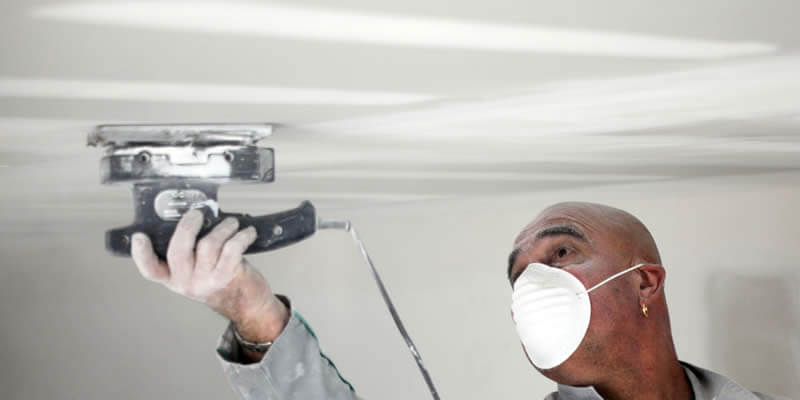Average Drywall Ceiling Installation and Finish Cost
The average cost to hang and finish drywall on a ceiling is $2.45 per square foot when a contractor is hired, or about $1,225 for 500 square feet. DIY installation costs .40 to .75 cents per sq. ft. for drywall and supplies.
A painting or drywall company will prepare the area for drywall by building a wood frame to mount the drywall to, if none exists. (Ex: Replacing a drop ceiling.) After the ceiling framework is in place, they’ll provide and install the drywall and fasten it with screws before taping all screw heads and seams between the drywall boards. Once the first coat of mud dries, they’ll finish the surface and install a second coat of mud to assure no seams and a smooth finish. If you plan to have popcorn blown onto the ceiling, it will be done at this stage and mixed with ceiling paint for a final finish. If it’s going to be painted, they’ll assure everything is smooth before appplying 2 coats of ceiling paint.
Average Costs
Overview of Finished Drywall Ceilings
Do you have water damage on the ceiling or want to replace or cover an outdated popcorn ceiling?
Whatever the reason, most homeowners hire a pro to install ceiling drywall, aka sheetrock, because of the challenge of getting pieces into place and holding them while screws are installed. It can literally be a pain in the neck, working above your head for long stretches. It doesn’t require as much skill as many other interior home projects, but it is a hassle. The hassle is multiplied if the work includes removing old drywall first, or refinishing the walls with drywall at the same time.
This cost estimate, what we call a Costimate, covers the cost to install drywall ceiling and add tape and mud. It does not include finishing drywall, which is a skill and project of it’s own in some cases. Cost factors are listed and explained.
There’s a list of retail drywall and supplies costs for DIY enthusiasts including the cost to rent a drywall hoist, which can make this a one-person job. We’ve also gathered estimates on the cost to drywall ceilings from reliable cost sites. Homeowners are invited to share their cost to sheetrock ceiling space, giving other readers real-life examples.
If the ceiling contains plumbing or electrical wiring you might want to access later, a drop ceiling might be a better solution. Project cost is higher, but it does allow easy access and no repair costs afterwards.
Ceiling Drywall Cost Factors
Ceiling drywall cost factors are meant to help you narrow down what your cost will be when you do it yourself or hire someone to do the work.
- Who Does the Work – Most of the cost to drywall ceiling is labor, so you can save up to 70% by doing it yourself.
- Ceiling Height – Ceilings 8’ to about 12’ can be done on stilts, a drywaller bench or ladders. Higher ceilings might require a lift or scaffolding, and that will push the cost toward the upper end of the price range.
- Ceiling Size – The more ceiling space, the more the total cost will be, but ceiling drywall cost per square foot goes down. Also, most contractors have a minimum labor fee of $200+ for bathrooms and other small ceilings.
- Ceiling Difficulty – The more corners the room has and the more ceiling cutouts for fixtures there are, the higher the cost will be for both material, due to added waste, and labor. The average price above accounts for 1 cutout per 100 square feet and a room with 4 or 6 corners.
- Ceiling Prep – If you’re covering an old ceiling, you might have to prep it first – such as scraping a popcorn ceiling. (Estimate with the popcorn ceiling removal cost calculator) When this approach is taken, the installer will also have to take time to use a stud finder to locate studs for installing drywall screws. This kind of prep costs up to $1.00 per square foot.
- Drywall Thickness and Type – There are slight cost differences between 3/8”, 1/2″ and 5/8” drywall. Mold and moisture-resistant drywall, or greenboard, costs a bit more. Retail costs are below.
- Drywall Removal – Removing old drywall adds 30 to 80 cents per square foot plus possible disposal costs. When you get estimates for the cost to sheetrock ceiling, compare the cost of covering vs removing the old drywall.
- Drop Ceiling Removal – Expect additional costs of 75 cents to $1.25 per square foot for removing false ceiling tracks and panels and disposing of the materials.
- Desired Finish – The type of finish, whether it be a perfectly smooth coat to popcorn or textured ceiling, is going to be a factor in your drywall ceiling cost.
Drywall and Installation Supplies Costs
If you’re putting together a supplies list and prices for how much to drywall a ceiling, here is what you’ll need and their costs.
- 25 to 40 cents per square foot | Standard Drywall Panels, 1/2″ and 5/8” thick. This works out to $8.50 to $18.00 per 4×8, 4×10 or 4×12 panels. Larger panels cost less per square foot and have fewer seams, so installation cost is lower too. But they are harder to work with for DIYers.
- 35 to 45 cents per square foot | Moisture-resistant Panels cost $12 to $22 per panel. Greenboard is recommended for bathrooms, kitchens and other areas where water/steam are common.
- 14 to 35 cents per linear foot | Drywall Corner Bead. Rolls of flexible metal or vinyl bead cost less per foot than 8’ sections.
- $2.25 – $6.00 per roll | Joint Tape, rolls 100 to 250 feet. Paper tape is cheapest. Vinyl mesh tape costs more.
- $3.00 – $5.50 per gallon | Joint Compound. Each gallon is enough for 1 coat of mud on the tape needed for 450 square feet of drywall.
- $6.00 – $20.00 per box | Drywall Screws. A 5lb box for $6 contains about 200 screws. A 20lb box for about $20 holds about 1000 screws. Each 4×8 panel requires about 36 screws, or one every 8” around the perimeter of the panel.
- $5.00 – $12.00 each | Basic Hand Tools you’ll need are a utility knife and blades, 6” taping knife, mud pan and keyhole saw.
- $35 – $75 | Homeowner-quality Drill or Driver. While drywall nails are used, screws are preferred for tightly securing drywall to studs.
- $40 – $50 per day | Rental of a Drywall Lift. Most local home improvement and rental stores have drywall lifts that raise drywall and hold it in place while it is fastened. Weekly rental cost is $150 – $200.
Permits, Inspection, Related Costs and Installation Time
Permits and Inspection Cost
- $0 | No permit is required for installing ceiling drywall.
Related Costs and Installation Time
Drywall installers are not as highly paid as other skilled trades people and contractors. Lower labor cost is the main reason that the cost of ceiling drywall is lower than drop ceiling cost.
Expect estimates on the cost to drywall ceiling in this range:
- $30 – $45 per hour | Labor Cost to Install Drywall Ceiling
Experienced drywallers hang about 50 square feet per hour. Consider a 15×20 room, or 300 square feet.
- Up to 4 Hours | Remove or Prep Old Drywall (optional)
- 5-7 Hours | Installation of 300 square feet of Drywall
- Up to 1 Hour | Site Cleanup
Related Projects
Here are several other common projects related to having drywall installed.
Pro Contributor, FMP Painting & Home Improvement

DIY or Hire a Pro?
I’ve hung ceiling drywall in a bathroom and bedroom after a leak in an upstairs bathroom caused water damage to the ceilings below. Both rooms have 9’ ceilings.
A friend helped, and we were able to work off of step stools. The demand for skill isn’t very high, but working overhead for hours on end isn’t much fun. Expect sore shoulders and neck if you tackle the job.
The keys to success I discovered include:
- Wear eye protection and a mask, and go slow when removing old drywall – cut along edges with a utility knife, and cut out pieces of drywall in 4×4 to 4×8 sections. This will reduce falling dust and debris.
- Remove all fasteners from the previous drywall (preferred) or drive them into the studs so that the new panels fit snug to the studs.
- Start hanging new panels where the old panels started. This will ensure that drywall sheet edges will fall on a stud. If you start in a different location, this might not happen, and you’ll have to add a “nailer,” a section of stud between ceiling joists to fasten the edge to.
- Align tapered edges. Panels have tapered edges that form a small channel for drywall compound. Aligning tapered edges, rather than a tapered and cut edge, will make the finisher’s job easier and improve the finished look. If you have to join a flat edge to a tapered, use a utility knife to taper the flat edge before hanging the piece.
- Measure twice, and cut once. This is doubly true when measuring for a cutout like a vent fan box or fixture junction box. For cutouts, measure to its center from two directions. Then measure the total size of the cutout, and use those dimensions to create the hole with a scroll saw.
- Watch a video tutorial or two like this one to see how experienced drywallers tackle the job and the techniques they use to get it right.
Videos will also help you decide whether it is a project you want to do yourself or hire it done.


 Steve Hansen, that's me, the Senior Editor of Costimates. (
Steve Hansen, that's me, the Senior Editor of Costimates. (